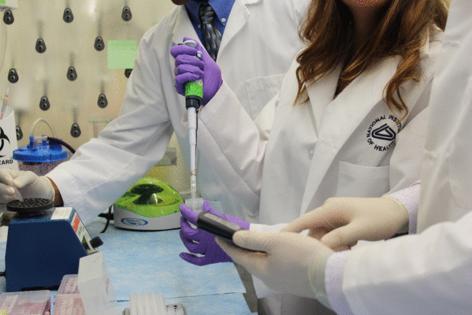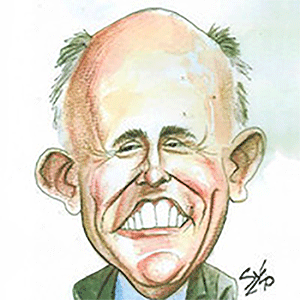NIH budget cuts threaten the future of biomedical research -- and the young scientists behind it
Published in Science & Technology News
Over the last several months, a deep sense of unease has settled over laboratories across the United States. Researchers at every stage — from graduate students to senior faculty — have been forced to shelve experiments, rework career plans, and quietly warn each other not to count on long-term funding. Some are even considering leaving the country altogether.
This growing anxiety stems from an abrupt shift in how research is funded — and who, if anyone, will receive support moving forward. As grants are being frozen or rescinded with little warning and layoffs begin to ripple through institutions, scientists have been left to confront a troubling question: Is it still possible to build a future in U.S. science?
On May 2, the White House released its Fiscal Year 2026 Discretionary Budget Request, proposing a nearly $18 billion cut from the National Institutes of Health. This cut, which represents approximately 40% of the NIH's 2025 budget, is set to take effect on Oct. 1 if adopted by Congress.
"This proposal will have long-term and short-term consequences," said Stephen Jameson, president of the American Association of Immunologists. "Many ongoing research projects will have to stop, clinical trials will have to be halted, and there'll be the knock-on effects on the trainees who are the next generation of leaders in biomedical research. So I think there's going to be varied and potentially catastrophic effects, especially on the next generation of our researchers, which in turn will lead to a loss of the status of the U.S. as a leader in biomedical research."
In the request, the administration justified the move as part of its broader commitment to "restoring accountability, public trust, and transparency at the NIH." It accused the NIH of engaging in "wasteful spending" and "risky research," releasing "misleading information," and promoting "dangerous ideologies that undermine public health."
To track the scope of NIH funding cuts, a group of scientists and data analysts launched Grant Watch, an independent project that monitors grant cancellations at the NIH and the National Science Foundation. This database compiles information from public government records, official databases, and direct submissions from affected researchers, grant administrators, and program directors.
As of July 3, Grant Watch reports 4,473 affected NIH grants, totaling more than $10.1 billion in lost or at-risk funding. These include research and training grants, fellowships, infrastructure support, and career development awards — and affect large and small institutions across the country. Research grants were the most heavily affected, accounting for 2,834 of the listed grants, followed by fellowships (473), career development awards (374) and training grants (289).
The NIH plays a foundational role in U.S. research. Its grants support the work of more than 300,000 scientists, technicians and research personnel, across some 2,500 institutions and comprising the vast majority of the nation's biomedical research workforce. As an example, one study, published in the Proceedings of the National Academy of Sciences, found that funding from the NIH contributed to research associated with every one of the 210 new drugs approved by the U.S. Food and Drug Administration between 2010 and 2016.
Jameson emphasized that these kinds of breakthroughs are made possible only by long-term federal investment in fundamental research. "It's not just scientists sitting in ivory towers," he said. "There are enough occasions where (basic research) produces something new and actionable — drugs that will save lives."
That investment pays off in other ways too. In a 2025 analysis, United for Medical Research, a nonprofit coalition of academic research institutions, patient groups and members of the life sciences industry, found that every dollar the NIH spends generates $2.56 in economic activity.
A 'brain drain' on the horizon
Support from the NIH underpins not only research, but also the training pipeline for scientists, physicians and entrepreneurs — the workforce that fuels U.S. leadership in medicine, biotechnology and global health innovation. But continued American preeminence is not a given. Other countries are rapidly expanding their investments in science and research-intensive industries.
If current trends continue, the U.S. risks undergoing a severe "brain drain." In a March survey conducted by Nature, 75% of U.S. scientists said they were considering looking for jobs abroad, most commonly in Europe and Canada.
This exodus would shrink domestic lab rosters, and could erode the collaborative power and downstream innovation that typically follows discovery. "It's wonderful that scientists share everything as new discoveries come out," Jameson said. "But you tend to work with the people who are nearby. So if there's a major discovery in another country, they will work with their pharmaceutical companies to develop it, not ours."
At UCLA, Dr. Antoni Ribas has already started to see the ripple effects. "One of my senior scientists was on the job market," Ribas said. "She had a couple of offers before the election, and those offers were higher than anything that she's seen since. What's being offered to people looking to start their own laboratories and independent research careers is going down — fast."
In addition, Ribas, who directs the Tumor Immunology Program at the Jonsson Comprehensive Cancer Center, says that academia and industry are now closing their door to young talent. "The cuts in academia will lead to less positions being offered," Ribas explained. "Institutions are becoming more reluctant to attract new faculty and provide startup packages." At the same time, he said, the biotech industry is also struggling. "Even companies that were doing well are facing difficulties raising enough money to keep going, so we're losing even more potential positions for researchers that are finishing their training."
This comes at a particularly bitter moment. Scientific capabilities are soaring, with new tools allowing researchers to examine single cells in precise detail, probe every gene in the genome, and even trace diseases at the molecular level. "It's a pity," Ribas said, "Because we have made demonstrable progress in treating cancer and other diseases. But now we're seeing this artificial attack being imposed on the whole enterprise."
Without federal support, he warns, the system begins to collapse. "It's as if you have a football team, but then you don't have a football field. We have the people and the ideas, but without the infrastructure — the labs, the funding, the institutional support — we can't do the research."
For graduate students and postdoctoral fellows in particular, funding uncertainty has placed them in a precarious position.
"I think everyone is in this constant state of uncertainty," said Julia Falo, a postdoctoral fellow at UC Berkeley and recording secretary of UAW 4811, the union for workers at the University of California. "We don't know if our own grants are going to be funded, if our supervisor's grants are going to be funded, or even if there will be faculty jobs in the next two years."
She described colleagues who have had funding delayed or withdrawn without warning, sometimes for containing flagged words like "diverse" or "trans-" or even for having any international component.
The stakes are especially high for researchers on visas. As Falo points out for those researchers, "If the grant that is funding your work doesn't exist anymore, you can be issued a layoff. Depending on your visa, you may have only a few months to find a new job — or leave the country."
A graduate student at a California university, who requested anonymity due to the potential impact on their own position — which is funded by an NIH grant— echoed those concerns. "I think we're all a little on edge. We're all nervous," they said. "We have to make sure that we're planning only a year in advance, just so that we can be sure that we're confident of where that funding is going to come from. In case it all of a sudden gets cut."
The student said their decision to pursue research was rooted in a desire to study rare diseases often overlooked by industry. After transitioning from a more clinical setting, they were drawn to academia for its ability to fund smaller, higher-impact projects — the kind that might never turn a profit but could still change lives. They hope to one day become a principal investigator, or PI, and lead their own research lab.
Now, that path feels increasingly uncertain. "If things continue the way that they have been," they said. "I'm concerned about getting or continuing to get NIH funding, especially as a new PI."
Still, they are staying committed to academic research. "If we all shy off and back down, the people who want this defunded win."
Rallying behind science
Already, researchers, universities and advocacy groups have been pushing back against the proposed budget cut.
On campuses across the country, students and researchers have organized rallies, marches and letter-writing campaigns to defend federal research funding. "Stand Up for Science" protests have occurred nationwide, and unions like UAW 4811 have mobilized across the UC system to pressure lawmakers and demand support for at-risk researchers. Their efforts have helped prevent additional state-level cuts in California: in June, the Legislature rejected Gov. Gavin Newsom's proposed $129.7-million reduction to the UC budget.
Earlier this year, a coalition of public health groups, researchers and unions — led by the American Public Health Association — sued the NIH and Department of Health and Human Services over the termination of more than a thousand grants. On June 16, U.S. District Judge William Young ruled in their favor, ordering the NIH to reinstate over 900 canceled grants and calling the terminations unlawful and discriminatory. Although the ruling applies only to grants named in the lawsuit, it marks the first major legal setback to the administration's research funding rollback.
Though much of the current spotlight (including that lawsuit) has focused on biomedical science, the proposed NIH cuts threaten research far beyond immunology or cancer. Fields ranging from mental health to environmental science stand to lose crucial support. And although some grants may be in the process of reinstatement, the damage already done — paused projects, lost jobs and upended career paths — can't simply be undone with next year's budget.
And yet, amid the fear and frustration, there's still resolve. "I'm floored by the fact that the trainees are still devoted," Jameson said. "They still come in and work hard. They're still hopeful about the future."
_____
©2025 Los Angeles Times. Visit latimes.com. Distributed by Tribune Content Agency, LLC.







Comments